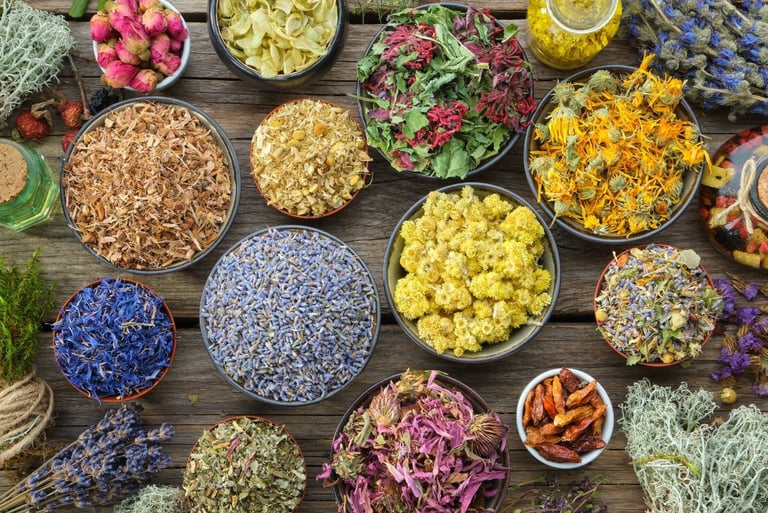How to Quickly Relieve Painful Period Cramps and Symptoms and feel more Peace
FEMALE HEALTHHEALTH & WELLNESS
Written by Keith - Nutritionist, Herbalist, and Reseacher
7 min read


For many women around the world, severe menstrual cramps continue to cause debilitating pain each month. Pain that men would think of as unbearable and dreadful yet is the norm for those living with dysmenorrhea. The pain and discomfort associated with menstrual cramps can vary from mild to severe, but more are experiencing severe pain than ever before. For some women, it's tough to even get up and function for several days each month, but we believe no matter how much pain and discomfort you may feel, it's possible to improve with different strategies.
I will try to steer clear of some of the same tips and treatments that many articles tout that are either useless or have serious side effects. The best way to improve PMS, PMDD, menstrual cramps, and pains is to take a multifaceted approach rather than rely on one thing alone. When it comes to defeating this stubborn nemesis and getting the best results possible, it's important to incorporate both short-term and long-term strategies. In this article, we will list ways to quickly improve menstrual cramps and period pains, as well as critical habits and long-term strategies that make a world of difference in making menstruation more peaceful each month.
1. Transcutaneous Electrical Nerve Stimulation (TENS Machines)
TENS is a therapy that involves low-voltage currents to be sent topically to the body to stimulate a response. They've been around for a while and have had several studies showing benefits. Studies with TENS units and menstrual pain have shown positive benefits, although it's certainly not any type of miracle pain reliever. In one study, 40 women with dysmenorrhea used TENS machines and compared them to sham therapy. The comparison to a fake TENS unit gives this study greater weight and credibility. When the results were compared, the real TENS machine helped to decrease the pain by over 50%, while the shame therapy did nothing.
Whether or not each person who tries this will see a reduction in cramp severity is tough to know because large-scale trials haven't been conducted, but it appears to have potential. Those who felt relief from menstrual cramps saw the results within around 20 minutes and the relief lasted almost 7 hours. That is certainly something that has enough potential to try, although not everyone will see amazing results for dysmenorrhea. Ideally, TENS therapy should be combined with other practices rather than relied on as a stand-alone pain reliever. 1
2. Heat Therapy (specifically with TENS therapy)
One of the most common and effective ways to alleviate menstrual cramps is by using heat therapy. Although heat therapy is almost always mentioned for menstrual pains, we are listing it as a synergistic therapy with TENS therapy. As a stand-alone pain reliever, it may not be strong enough to give long-lasting relief to those with severe menstrual cramps. However, as a synergistic therapy with TENS, it can be a solid 1-2 punch that can make a significant difference.
A meta-analysis of several studies on heat therapy for dysmenorrhea concluded that its effects were significant at lowering menstrual pain and comparable to oral pain relievers. 2 Applying heat to the lower abdomen helps to relax the muscles and reduce pain. Moist heat may penetrate more deeply and offer greater benefits for cramps than dry heat. Applying moist heat before or after a session with a TENS unit will help to increase circulation and oxygenation, as well as stimulate endorphin release to help relieve menstrual cramps.
3. Herbal Medicine
Herbal medicine can be a powerful ally in lowering menstrual pain fairly quickly. While it may not provide the quick pain relief of high doses of NSAIDs or medication, many herbal formulas have a higher ceiling to improve the overall condition and a lower risk of side effects. This is because of the wide range of therapeutic and protective actions of herbs, although caution is still advised with any supplement. It can take patience when sifting through all the possible natural remedies, as not all natural treatments will work quickly or even at all. It depends on herb quality, if the specific herb is right for your symptoms, and how well your body utilizes it. However, the right combination of herbs or nutrients can make a world of difference for menstrual pain, PMS, and cramps.
Some useful herbs for dysmenorrhea are pandan leaf, squawvine partridge berry, sweet marjoram, lemon verbena, saffron, fennel, raspberry leaf, black haw, motherwort, ginger, lemon balm, silverweed (potentilla anserina) and cinnamon. These herbs can be extremely helpful in fighting many of the underlying causes of menstrual cramps such as high prostaglandin production, inflammation, poor circulation, spasms, and more. 3 However, for the most complete healing possible, dietary changes are necessary as well and will provide an excellent foundation for calming stubborn cramps and pains.
4. Dietary Changes
The weight of our diet on overall health and wellness cannot be emphasized enough. When we think about external influences on our cells, genes, and systems of the body, diet is at the very top. Other factors such as EMFs and the environment are also important but can be tougher to change. What you eat can either help or hinder the amount of pain you feel each month by influencing prostaglandins, inflammation, circulation, and the health of every single organ in the body. Incorporating specific foods into your diet is a critical step in experiencing a more peaceful menstrual cycle. Avoiding fried foods, trans-fats, vegetable oils, insulin-spiking, high glycemic foods, and empty calories that are lacking in overall micro-nutrient content is critical. These foods cause inflammation, hormonal imbalances, and poor overall health.
Focusing on a diet that's rich in omega-3 fats, anthocyanins, potassium, magnesium, zinc, b-vitamins, and other nutrients will create a positive shift in the right direction. Some great examples include sprouted walnuts, sprouted pumpkin seeds, wild-caught salmon, sardines, pomegranate, bilberries, purple rice and potatoes (not fried), grass-fed beef, oysters, beef liver, watercress, carrot juice, and others will help to replenish nutrients and cut down on inflammation. Improving the ratio of potassium to sodium is very helpful in reducing menstrual cramping and bloating. In addition, cutting down or abstaining from caffeine for 3-5 days before menstruation will also be helpful, as it can increase the severity of cramps.
5. Therapeutic Baths




Bath therapy is an underrated tool for health and wellness. With the right ingredients, baths can provide tremendous support in detoxifying the body, improving circulation, enhancing lymphatic flow, lowering inflammation, decreasing stress, and soothing away tension. All of this translates into significant benefits for anyone suffering from painful periods. However, without the right ingredients and process, the benefits won't be as pronounced.
Most city water is very dirty, so it's important to add ingredients that will nullify the chlorine and other toxins in tap water. A good quality shower or bath filter is a great investment to help lower the toxic burden each day. First, look for a vitamin C powder in the form of sodium ascorbate. This will help to neutralize chlorine and chloramine. Next, try to find a couple of different types of pure clays to add to the bath. This will provide a highly potent electromagnetic charge with minerals that enhance the therapeutic value. A bath will not be nearly as beneficial without a good clay blend.
We recommend Russian Cambrian Blue Clay, Sacred Clay (from Vitality Herbs & Clay), and Rhassoul Moroccan Clay. Lastly, mix a couple of types of magnesium. Epsom salt is very inexpensive, but won't give maximum benefits. Magnesium is incredibly important and beneficial for menstrual cramps and pains so choosing forms that absorb well in the body is critical. There is no faster way to elevate your levels than from a bath. We recommend going with magnesium flakes (Zechstein sea magnesium is a very pure source) and Epsom salt.
6. Exercise
Engaging in regular physical activity can have a positive impact on menstrual cramps and period pains. While it won't do miracles on its own, several key components of exercise contribute to a less strenuous, more peaceful cycle, especially when combined with the other tips on this list. Exercise helps to stimulate the lymphatic system, enhance circulation and oxygenation, release endorphins, and lower stress. Making sure to exercise consistently a week or two before menstruation is especially important. However, without a good diet and incorporating other natural remedies, it will be an uphill battle. One study found that both low and high impact exercise helped reduce the severity of period pain when compared to not exercising at all. 4
7. Over-the-Counter Pain Relievers
We like to encourage people to go the natural route as much as possible but understand that some medication or over-the-counter pain relievers may be needed at times. Nonsteroidal anti-inflammatory drugs (NSAIDs), such as ibuprofen or naproxen, can help give quick relief for some people, but not work on others. Although they are strong and can reduce inflammation, some people fail to see the results they're looking for from NSAIDs. It's important to follow the recommended dosage and consult with a healthcare professional if you have any concerns or underlying health conditions.
8. Talk to a Healthcare Professional
If your menstrual cramps are severe, persistent, and aren't responding to other interventions, it's important to consult with a qualified professional for further testing. They can help with understanding if perhaps there may be other conditions that are contributing to severe pain. Although around 90% of women who experience menstrual pain are from primary dysmenorrhea, some may experience pain due to secondary dysmenorrhea. Although everyone has unique causes for experiencing menstrual cramps & pain, there is always hope to improve no matter how bad things may currently be. It may take some trial and error to find the most effective methods for period pains. We hope these tips will help you feel more peace and comfort during your cycle each month.
References:
1. https://www.sciencedirect.com/science/article/pii/S1166708722000288
2. https://www.ncbi.nlm.nih.gov/pmc/articles/PMC6214933/
3. https://www.ncbi.nlm.nih.gov/pmc/articles/PMC4177637/